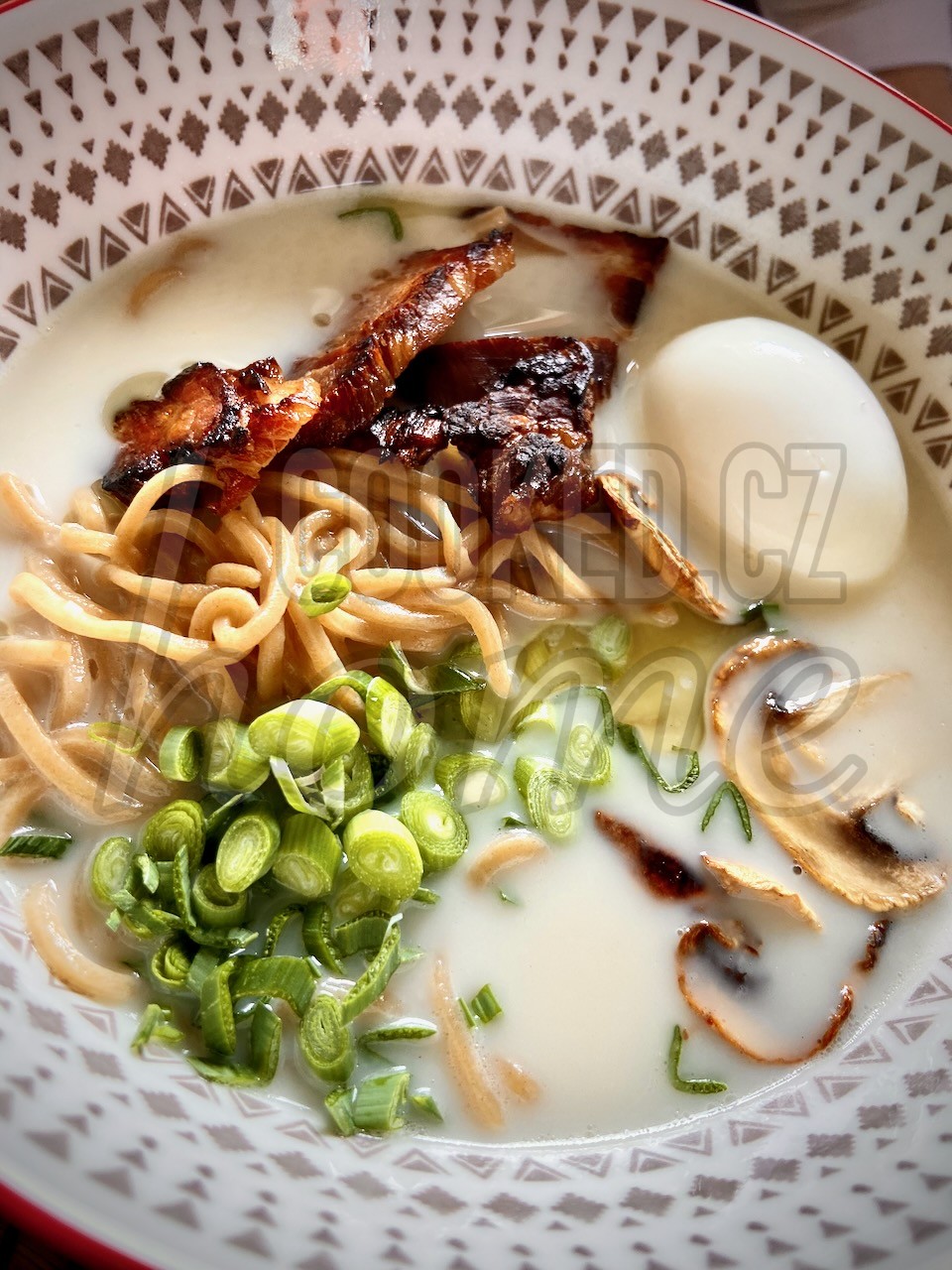Tonkotsu broth is made by simmering pork bones, typically including pork trotters or knuckles, for an extended period of time. The long cooking time allows the collagen and marrow from the bones to dissolve into the broth, resulting in a thick and milky consistency. The broth is often seasoned with soy sauce, salt, or other umami-rich ingredients to enhance its flavor. The origins of tonkotsu broth can be attributed to the rise of ramen culture in post-World War II Japan. During that time, a restaurateur named Nagahama Yasuji opened a ramen shop called "Ajitoya" in Hakata, Fukuoka. Ajitoya specialized in serving a new style of ramen that featured a creamy and flavorful pork-based broth, which eventually became known as tonkotsu ramen.
Ingredients

Nagahama Yasuji developed the technique of boiling pork bones for long hours to extract their rich flavors and create a hearty broth. The resulting tonkotsu broth was different from the lighter soy-based broths that were more commonly used in ramen at the time. The Hakata-style tonkotsu ramen quickly gained popularity in Fukuoka and eventually spread to other parts of Japan.
Directions
Optional Step
- Place all bones in to the water and refrigerate overnight.
- This helps to get out impurities, bad smell and we will have less work skimming.
- Blanch the bones. Place them in a large stockpot, cover with cold tap water, and set over high heat.
- Bring to a boil, then down to a simmer, and skim the scum that rises to the top of the pot.
- Do this for 15-20 minutes, or until little scum is rising.
- The scum goes through several phases here, you’ll know when the scum is pretty much done rising.
- This blanch is integral for a white tonkotsu, don’t skip it, and don’t end it prematurely.
- Transfer to Pressure cooker add halved onion and ginger.
- Pressure cook for 2 hours and 30 minutes on highest pressure.
- Cover bones with minimum 2 inches of water, I prefer to have bones completely covered.
- After time elapses use fast release.
- If needed add additional water to have approximately 3l of water.
Optionally, you can remove ginger and onion and continue to boil until there is no cartilage or soft tissue left on the bones and they look bare, adding water as needed to keep the water level high, approximately 1 hour more. This will result into more rich broth.
- Strain the stock into a clean stockpot or large bowl. Discard the solids.
- Prepare immersion blender and emulsify the soup, mixing at least 5 minutes.
- Stock should become milky white.
- Store in the fridge safe container and refrigerate as soon as possible.
- After stock has chilled, you can scrape the fat from the top in to separate container.
- Store in the fridge indefinitely. Fat can be used for flavoring ramen.
Using soy sauce base tare will ruin the milky white presentation of the broth. However from taste perspective I really prefer shoyu tare.
- Choose “tare” flavoring I recommend using bare bones shio tare.
- Serve 300ml of soup per portion with 30ml of tare.
- For flavoring I recommend using scallion oil.
- Serve with approx. 130g of ramen noodles.
Ingredients
Directions
Optional Step
- Place all bones in to the water and refrigerate overnight.
- This helps to get out impurities, bad smell and we will have less work skimming.
- Blanch the bones. Place them in a large stockpot, cover with cold tap water, and set over high heat.
- Bring to a boil, then down to a simmer, and skim the scum that rises to the top of the pot.
- Do this for 15-20 minutes, or until little scum is rising.
- The scum goes through several phases here, you’ll know when the scum is pretty much done rising.
- This blanch is integral for a white tonkotsu, don’t skip it, and don’t end it prematurely.
- Transfer to Pressure cooker add halved onion and ginger.
- Pressure cook for 2 hours and 30 minutes on highest pressure.
- Cover bones with minimum 2 inches of water, I prefer to have bones completely covered.
- After time elapses use fast release.
- If needed add additional water to have approximately 3l of water.
Optionally, you can remove ginger and onion and continue to boil until there is no cartilage or soft tissue left on the bones and they look bare, adding water as needed to keep the water level high, approximately 1 hour more. This will result into more rich broth.
- Strain the stock into a clean stockpot or large bowl. Discard the solids.
- Prepare immersion blender and emulsify the soup, mixing at least 5 minutes.
- Stock should become milky white.
- Store in the fridge safe container and refrigerate as soon as possible.
- After stock has chilled, you can scrape the fat from the top in to separate container.
- Store in the fridge indefinitely. Fat can be used for flavoring ramen.
Using soy sauce base tare will ruin the milky white presentation of the broth. However from taste perspective I really prefer shoyu tare.
- Choose “tare” flavoring I recommend using bare bones shio tare.
- Serve 300ml of soup per portion with 30ml of tare.
- For flavoring I recommend using scallion oil.
- Serve with approx. 130g of ramen noodles.